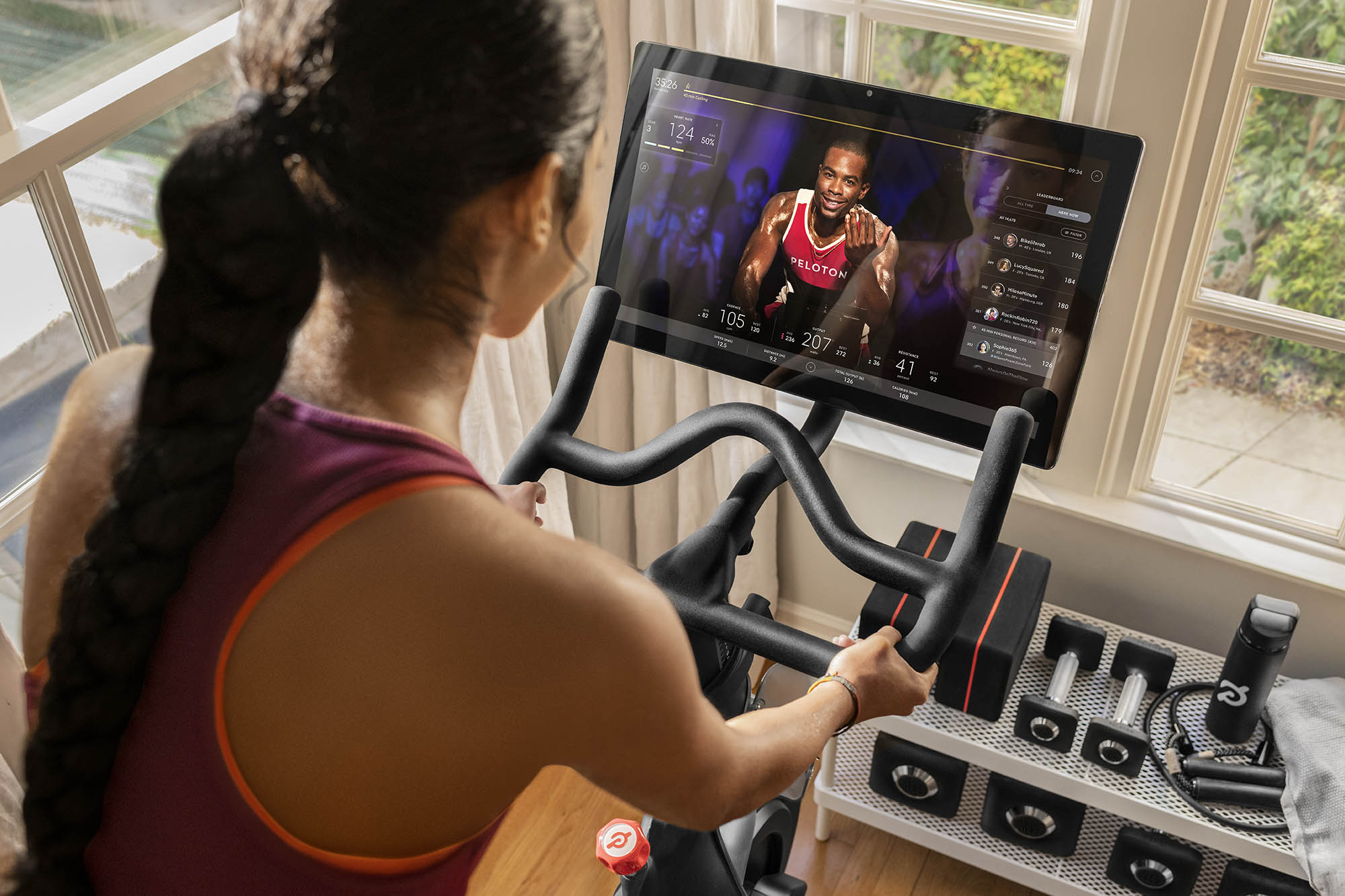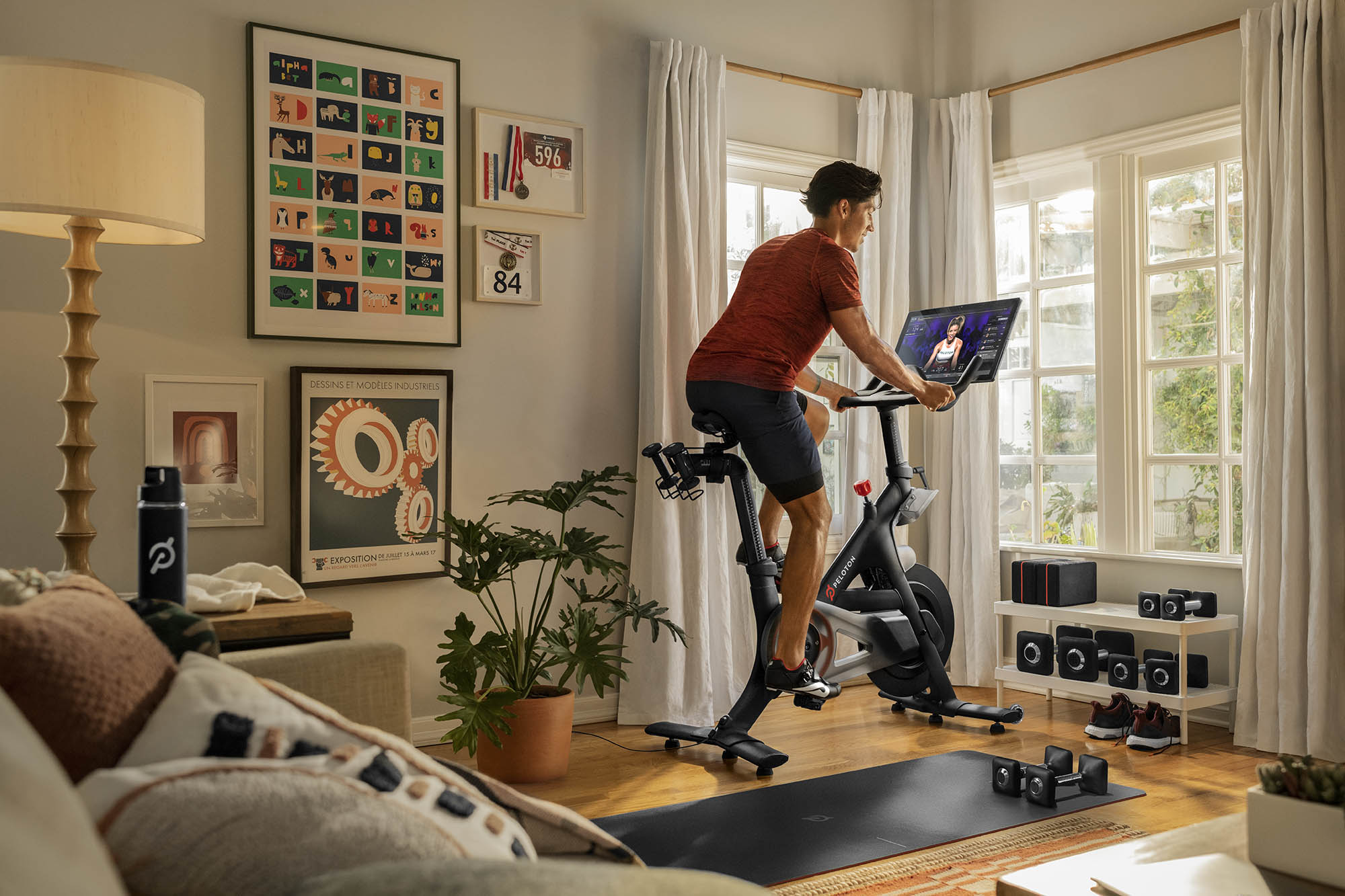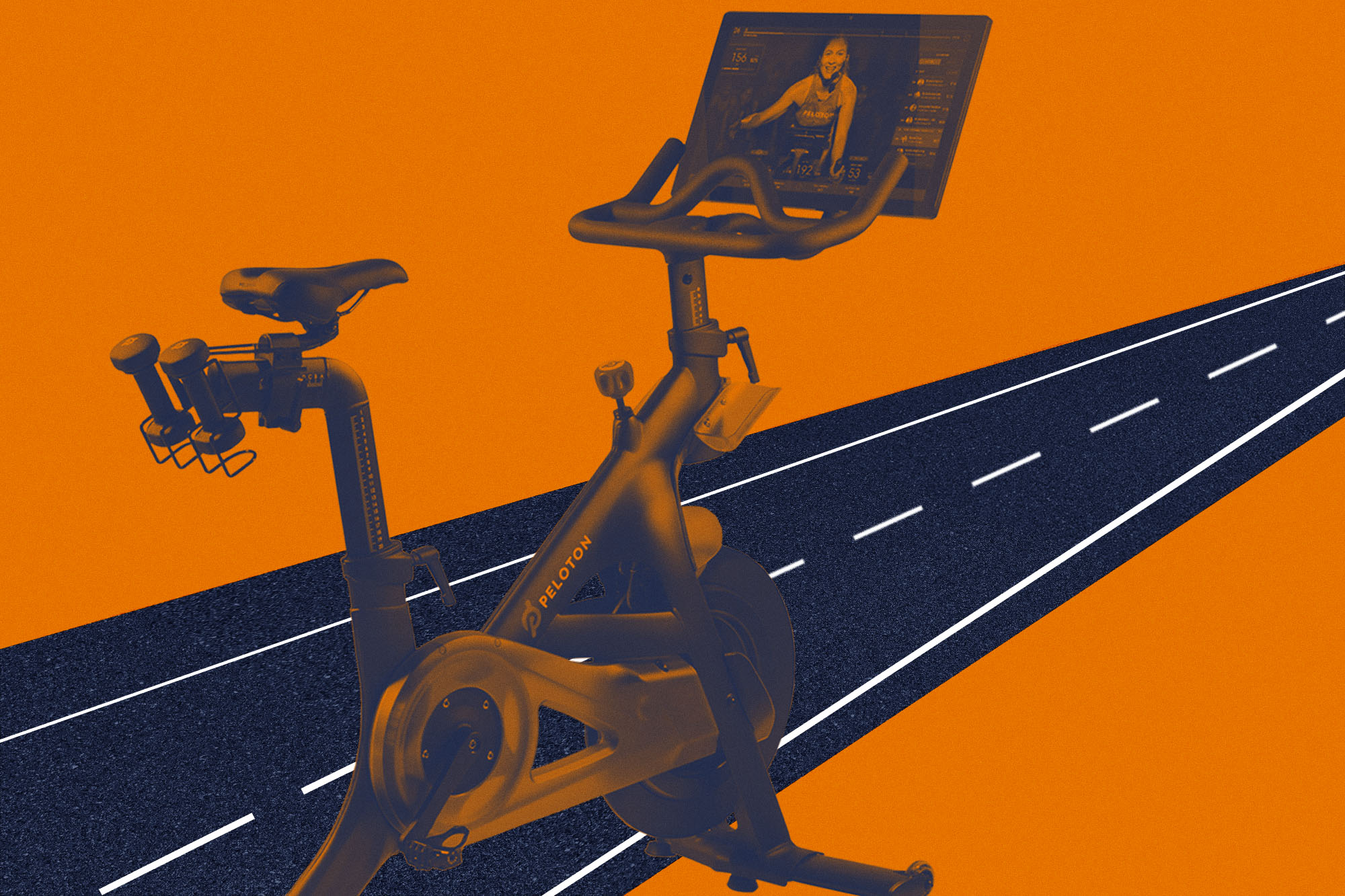It seemed like there was never anything very sexy about a stationary bike – until Peloton came along.
The American company has taken a product that appeared ordinary to many and turned it into something that people all over the world are dying to get their hands on – despite a hefty $1,895 price tag, plus a monthly membership fee.
With many gyms closed and people still working from home during the pandemic, that thirst has grown even more. The current wait time for the latest model of the bike is between 10 and 12 weeks, which means even if you were to order one right now to try and burn off those holiday calories to fulfill a New Year’s resolution, it might not arrive until the spring.
Launched in New York City via a Kickstarter company in 2013, Peloton is now a publicly traded company that, in its initial offering, was valued at more than $8 billion. In November, Peloton announced a 232% surge in sales.

The bike uses a video monitor mounted between the handlebars to stream its spin classes to riders in real time, but one of the big drawing cards is that the workouts can be done whenever – and with whomever – you want.
Some people ride virtually with friends, family members and coworkers. Others prefer to go solo.
Riders can compete and see how they stack up against millions of others from around the world, Or not; there are non-competitive options.
Riders love the workouts, which allow them to burn a large number of calories in a short amount of time. They love the personable instructors. They love the music. Many love the competitive aspect. Most of all, they seem to love the community of it.
Exactly 1 Year and 400 Rides later, my life has never been better! What @onepeloton has done for me physically and mentally is beyond measure! So happy I started this journey a year ago to make myself an all around a better human being! pic.twitter.com/LCeunEl69s
— MarshallSwaim (@MarshySmiles) November 19, 2020
Here’s why i love @onepeloton — my former @MSUgymnastics teammate and friend that lives in New York was able to still beat me by 1 while I spin in California! #gogreen pic.twitter.com/QukjbghcxU
— Jennifer (@calispartan7) October 10, 2020
Mental Health effects us ALL! honored to get to be apart of your fight through this @onepeloton community. https://t.co/QJrWODZOZL
— Kendall Toole (@fitxkendall) October 12, 2020
What a way to celebrate our LatinX community! The magic is on-demand in case you missed it Live. @onepeloton x @momento_latino pic.twitter.com/ZlEP0T32w1
— Robin Arzón (@RobinNYC) October 9, 2020
However, Peloton – just like anything in life – isn’t perfect.
Many riders, including former University of Virginia football star Chris Long – whose wife bought him a bike for Christmas in 2019 – have said the seats are uncomfortable.
Btw. No way I’d buy a peleton... not because of an ad.... the seats hurt.
— hydrated king chris long (@JOEL9ONE) January 1, 2020
Others say the virtual leaderboard – one of Peloton’s big selling points – is meaningless, due to the inconsistent calibrations of bikes.
And lately Peloton has run into customer service issues stemming from the tremendous demand for the bikes that they have had trouble meeting, though its recent acquisition of fitness equipment maker Precor is aimed at fixing that.
For a deeper dive into the Peloton craze, UVA Today turned to engineering professor Gavin Garner.
Garner holds master’s and Ph.D. degrees from UVA in mechanical and aerospace engineering. He also happens to be an exercise enthusiast who regularly rides his girlfriend’s Peloton bike, as well as other stationary bikes like it.
Q. What do you think has made Peloton so successful?
A. The genius behind this brand isn’t in the bike’s mechanical design (I actually find that to be a little disappointing compared to other brands) but in the internet connectivity of the attached Android tablet with its giant touchscreen, and the psychological tricks that are used to motivate users to participate more often.
This motivation is achieved through social-media-style tactics (getting/sending updates on how friends and family are doing on their bikes), along with entertaining instructors and music during live or previously recorded sessions, plus special rewards such as getting sent a coveted T-shirt after your first 100 rides (there’s no other way in the world to get one of these “free” T-shirts, so they’re instantly recognizable and respected within the Peloton “cult” and people seem very proud to get and wear them).

An exercise enthusiast, Garner says there are several factors to consider when deciding whether to purchase a Peloton. (Photo by Dan Addison, University Communications)
Another clever psychological incentive Peloton uses is that instructors try to give individual users a “shout out” at some point during the class if it’s a very special occasion like their 100th or 1,000th ride; there are usually hundreds of people in a class, so it can feel like a big deal if they actually shout out your username during it.
You can also give random people virtual “high-fives” during or after a class. For example, you could offer a high-five to someone who you think has a clever username or to someone who you were neck and neck with in your heat of that day’s “race.”
Q. From a mechanical perspective, can you give us a quick break down of how a Peloton works?
A. Pelotons work like most other modern exercise bikes and incorporate powerful permanent magnets that are moved closer to or farther away from a large aluminum flywheel disk that spins around as you pedal. Normally magnets are not attracted to non-ferromagnetic aluminum, but because of the spinning motion of the disk, free electrons within the aluminum are influenced by the magnetic fields as they pass by and these electrons circulate inside the disk to create eddy currents (kind of like water eddies forming behind a rock in a stream), and these electrical eddy currents generate their own counter magnetic fields that oppose that of the permanent magnet, which thereby tries to slow down the spinning disk. So, the closer the permanent magnets are moved toward the aluminum disk, the harder it is to pedal – and the more calories you burn trying!

One of the big drawing cards of a Peloton is that workouts can be done whenever – and with whomever – you want. (Photo courtesy Peloton Interactive Inc.)
Q. In reading discussions within forums, people say Peloton has both “hard” and “easy” bikes. Doesn’t that defeat the purpose of a leaderboard if the playing field isn’t level?
A. Unfortunately, accurately calibrating these bicycles so that resistance values are consistent, and classes are comparing apples to apples on the scoreboard continues to be a major problem/annoyance for Peloton users. Naturally, people tend to get competitive, but oftentimes the ones who “win” the live cycling classes, out of hundreds of participants, seem to have superhuman statistics, suggesting that they may have just cheated and modified their bikes (e.g. so that the bike’s computer thinks that the resistance is very high, when, in reality, the magnets may not actually be all that close to the disk) or perhaps they just got lucky with bikes that were miscalibrated at the factory or knocked out of alignment during shipment (kind of like having mirrors that make you look skinnier than you really are).
Q. From an engineering perspective, is there anything Peloton can do to fix the problem at its core so that riders are all on a level playing field?
A. I dug into this a little and found that a key patent for magnetic resistance bikes was awarded to Nautilus Inc. (a leading manufacturer of exercise equipment) in 2013. Surprisingly, the drawings for the mechanism described in this patent look virtually identical to the mechanism that adjusts the resistance in Peloton bikes. It’s therefore likely that Peloton is just licensing this technology directly from Nautilus, and I’d guess that this might account for a substantial portion of the cost of their bikes (for example, Nautilus sells its Bowflex C6, a very similar bike – albeit without the Android tablet – for roughly half the cost of a first-generation Peloton). This patent shows three pairs of powerful magnets on both sides of a fork that hug the aluminum disk and are pivoted up and down to adjust their engagement with the disk.

Garner says the drawings for a mechanism described in a Nautilus Inc. patent look virtually identical to the mechanism that adjusts the resistance in Peloton bikes. (Patent illustrations by Nautilus Inc.)
While this would be fine for adjusting the resistance to the rider’s preference on a normal exercise bike (as Nautilus originally intended), this layout makes accurately measuring and displaying the power output significantly more difficult. The intensity of the magnetic fields and the forces that they exert are inversely proportional to the square of the distance they are away from the aluminum disk. If the magnets were only engaging the disk from one side (as on the Keiser bikes in the UVA Rec Sports facilities), then it would be much easier to measure this distance using a single distance sensor and use this measurement to calculate the resistance value in real time.
Instead, it seems that Peloton bikes must be calibrated using sophisticated equipment at the factory that create a lookup table that maps the complex non-linear performance of each bike as it comes off the line. In other words, it is as if each bike has its own unique fingerprint of resistances programmed into its memory that attempts to map the angle of the resistance knob to the actual magnetic resistance value at that angle. Unfortunately, if the bike is mishandled during shipping or tampered with by a user in any way after it leaves the factory, none of this is taken into account when displaying the user’s power output.
Q. A common theme in modern engineering – and especially within your specialty of mechatronic systems – is open-loop vs. closed-loop control. Can you explain how this relates to Peloton?
A. If cost and complexity isn’t an issue, then one would always prefer to have a closed-loop feedback control system. Ideally, you would like feedback directly from the parameter that you are interested in controlling. On an exercise bike, this would mean monitoring the mechanical power that is being put into the system by the rider.
I remember a few years ago, there were some exercise bikes installed at our Aquatic and Fitness Center that actually generated electricity that was then fed back into the power grid. On these, it would be very easy to measure exactly how much energy the rider was expending, since nearly all of it was being converted into electrical power and one can easily measure voltage and current to determine this value. I thought that this was a neat idea and gimmick to incentivize people to work out harder – and help to save the environment at the same time!
Unfortunately, all of the mechanical power that a rider pumps into a Peloton is simply dissipated away as heat within the aluminum disk. However, the amount of power involved in a typical workout is only a drop in the bucket compared to the daily average electricity used by a typical American. For example, an experienced Peloton rider may be able to average around 200 watts of output for 30 minutes during a workout, which equates to about 0.1 kilowatt-hours of energy. The average American home uses around 30 kilowatt hours of electricity per day, which is about 300 intense workout rides worth of energy each day!
Q. Since the cost of a Peloton could be prohibitive for a lot of people – and the wait time is so long right now to get one – are there some other stationary bike options on the market that might provide a similar experience?
A. One thing that intrigued me while researching this was the idea of people getting a Nautilus Bowflex C6 (which is not currently backordered) and installing the Peloton app on an Apple or Android tablet that they probably already own. Other than the bigger touch screen on the Peloton, it seems like nearly the exact same experience at half the cost – and one may even be able to cast their tablet’s screen to a smart TV in the room that’s significantly bigger than the Peloton tablet’s screen to get the best of both worlds! The Peloton app can also be installed directly on some smart TVs. Zwift also seems worth exploring for those who take training and competition more seriously, since they seem to have the calibration issues all worked out on their compatible smart trainers, and this allows for virtual races with consistent results and real, definitive winners and losers.

If you want all of the fun and excitement of joining a spin class from within the comfort of your own home, Garner says a Peloton might be for you. (Photo courtesy Peloton Interactive Inc.)
Conclusion
So is a Peloton worth it? It depends who you ask.
Many people who own Pelotons swear by them. Many people who don’t – or have never tried one – don’t understand what all the fuss is about.
In trying to decide whether to purchase a Peloton, here are some key factors to consider, according to Garner.
Are You a Gadget Person?
Do you absolutely fall in love with gadgets like an iPhone, wherein the user interface is polished and intuitive, and are you willing to pay a steep premium for such ease/joy of use? If so, maybe the Peloton is for you. However, if you’re comfortable with figuring out how to use Android phones and tablets for example, and you don’t mind a slightly more clunky interface, there may be other ways that you can get this same type of Peloton experience for a lot less money (for example the Nautilus Bowflex C6 with the Peloton app running on a separate tablet or smart TV).
Friends and Family
Do you have friends or family members that own Pelotons with whom you would want to work to improve your fitness or their fitness? Support systems – and mutual accountability – can motivate users to come back again and again.
Fitness Goals
Do you think you would be motivated by being recognized by the software – and if you’re especially lucky, by a live instructor – for achieving lots of little goals and merit badges along the way? While this may sound a bit contrived, this incentive system seems to work well in helping millions of Peloton customers to get in better shape.
The Cost
Are you willing to pay a hefty $39 per month ($468 per year) subscription fee in perpetuity in order to continue to use your bike? Without this subscription and internet connectivity, the Peloton bike is just an ordinary exercise bike.
Also, beware there’s no guarantee that Peloton will not increase this fee in the future or improve their technology in such a way that forces you to shell out for a new, upgraded bike.
Convenience
Do you want all of the fun and excitement of joining a spin class in real life anytime you want from within the comfort (and safety) of your own home? You can also enjoy virtual joy rides through famous places and parks throughout the world – in other words, it can be like virtual travel! The Peloton app also provides you with access to classes beyond just bicycling including strength training, yoga, running, stretching, and meditation – and things just keep getting better as the community and environment continue to expand.
Media Contact
Article Information
January 5, 2021
/content/peloton-worth-it-engineering-professor-weighs-craze

